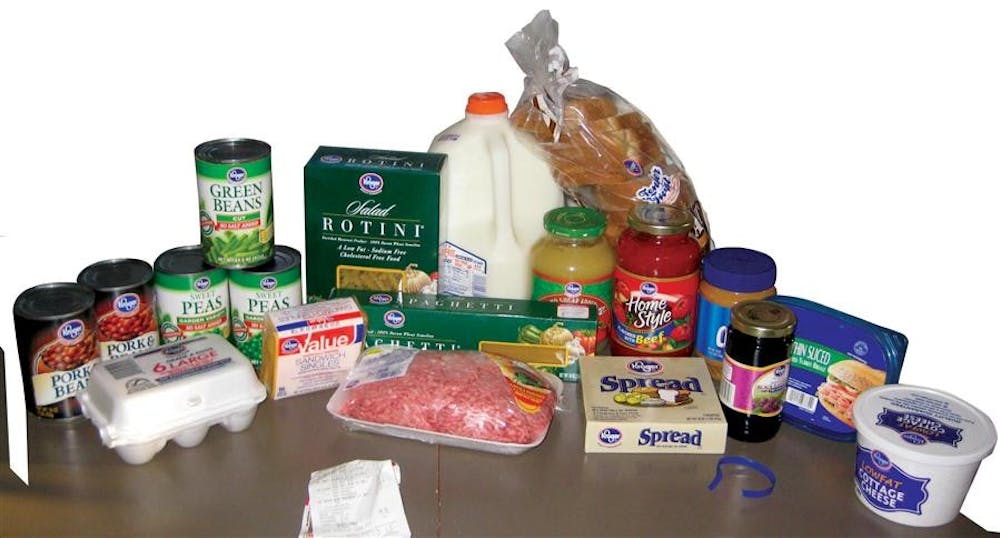The grocery store isn’t the first place people go to show off their wealth. For the most part, buying food is a fairly unglamorous procedure, often undertaken on a Sunday afternoon while wearing the last clean pair of clothes from the week before. But as I pushed a shopping cart through Kroger, carefully adding the price of each item I put in it, I discovered just how much an individual’s groceries say about his finances.
I’ve never considered myself greedy, especially in respect to food. But when I shop for groceries, what I want, I get. It was only when I stepped into the shoes of those who have too little that I realized my own greed.
That’s why I decided to go on food stamps.
NICKELS AND DIMES
The United States Department of Agriculture stipulates that the maximum food stamp allotment for a single-person household is $155 a month. That translates to roughly $5.09 per day or $25.45 for a five-day week.
Cruising the aisles, I thought about how far 25 dollars, four dimes, and a nickel go in Bloomington. That amount can buy you four chicken burritos at Chipotle, six large lattes at Sugar & Spice, or two large cheese pizzas with breadsticks from Aver’s.
As I quickly realized I wouldn’t be eating out this week, I played the numbers game to figure out how to throw together enough healthy meals to last me until Friday: each day I would need three meals, 2,000 calories and 65 grams of fat, and they couldn’t all come from Ramen noodles.
Usually when I shop, I haphazardly throw whatever looks good into my cart, then fill in the gaps later by ordering pizza or buying a sandwich at Jimmy John’s. But this time I had to actually calculate the values of what I was putting into my cart and pass up some of my diet staples, which were now too expensive.
The first to go were fresh fruits and vegetables, frozen pizzas, chicken breast, Cheerios, even my Diet Coke. I realized I wouldn’t be eating any of the foods that made me happiest. I thought, too, about the nutritional quality of the foods I would be eating. In my cart, preservative-free, vitamin-enriched items were replaced by processed, bargain basement alternatives. Organic foods were out of the question.
My designer foods were replaced by generic brand items. I felt like I was wearing sweatpants at a black-tie party. I was comforted by the thought that I would return to my old diet in only five days. But at the same time, I realized that the people who make this kind of low-budget grocery trip in order to piece together meals for their families – not to provide inspiration for a magazine story – don’t get to wake up one day free of the restraints of food stamps. On Saturday I would have meals that were not only healthy, but exciting, waiting for me. Those who live on food stamps month after month would not.
Contemplating a week of pork and beans, unsalted canned peas, peanut butter and jelly sandwiches and cheap pasta dishes, I pushed my half-empty cart toward the checkout. With my Kroger Plus savings card, my receipt totaled $22.91. Just $2.54 to spare.
HERE GOES NOTHING
My first meal on the food stamp program came at 8 a.m. Monday morning in the form of two eggs, toast and a glass of milk. Eggs are surprisingly inexpensive – a half dozen cost only 85 cents – but the prospect of cholesterol overload kept me from scrambling every meal.
Lunch consisted of a peanut butter and jelly sandwich and cottage cheese. For dinner, I made spaghetti with pasta sauce and beef, which I would eat as leftovers the next three days. For a side, I added a can of peas, with butter for flavor.
My first day was going well until noon, when I realized I needed caffeine. I returned to Kroger and headed to the coffee aisle, where I found that even Kroger Value coffee grounds were too expensive for my budget. I had to settle for Kroger-brand tea, which has only a fraction of the caffeine, for 94 cents.
That incident set the tone for the rest of the week. Many of the items I relied on every day were no longer within my reach. I couldn’t simply stop at the Union and grab a cup of coffee or buy an apple for a quick snack. My budget limited what I could eat and drink.
Of course, food stamps are intended to be a supplement to a person’s normal income and may be used alongside other government aid programs. But, as I quickly discovered, that doesn’t mean it’s easy. How can real families make it on this little?
“Is it tough to make it on food stamps? Of course,” says David Smalley, a food-stamp policy expert at the Indiana Family and Social Services Administration, as I talked to him about my experience. “But you hope there’s something else going on in the form of other sources of income.”
However, in 2005, the majority of food-stamp households did not receive any additional cash from the government, and 14 percent reported no cash income of any kind, according to data from the USDA. I realized I was only getting a taste of what it was like to live in poverty.
The next few days followed Monday’s meal pattern: eggs for breakfast, a sandwich for lunch, and a pasta dish for dinner (usually leftovers). Each meal was rounded out by either toast, cottage cheese, apple sauce or canned vegetables.
The plan worked for the most part, with a few exceptions. On Tuesday, disaster struck when I dropped the carton of eggs with two still left inside. The yolky casualties
demonstrated how small accidents can turn into catastrophes for those with limited incomes.
On Thursday, an attempt to make homemade macaroni and cheese by melting sandwich singles over pasta resulted in a bland, yellow-tinged dish that made me feel queasy when I ate it (and for hours after). And, unfortunately, my limited food supply meant that I had to eat it for two more meals.
On Friday, I gave into temptation and, with my last few quarters, bought a pack of 14 miniature candy bars to break up the monotony of my bland meals. The only times I found myself craving food were when I was away from the kitchen and couldn’t simply grab a quick bite from McDonald’s or the Union cafeteria.
Instead, I had to wait until I could trek home and take the time to prepare processed-turkey sandwiches, tasteless canned vegetables and sometimes-questionable pasta dishes.
Food stamps were not only limiting my eating choices. They were eating up my time, too.
POOR PERSON, RICH COUNTRY
To cap off my week, I was invited to dinner with my aunt at Little Zagreb’s, the much-touted downtown steak house. Most of the entrees on the restaurant’s menu exceeded my weekly budget, so while fellow diners feasted on filet mignon, baked potatoes, and fresh rolls, I stuck to the complimentary ice water and waited until I got home to dine on leftover macaroni and cheese and soggy green beans.
I watched while my girlfriend, sister, and aunt, along with everyone else in the restaurant, ate the kind of juicy tenderloins and steaks that I had been forced to give up in exchange for pale, sliced turkey and ground chuck. Aside from testing my willpower, the experience provided a reality check. I was caught in the middle of a demonstration of the perils of a poor person living in a rich society.
Renowned economist Adam Smith noted that the poor struggle not only to provide food and shelter for their families, but also to keep up with richer neighbors in order to “appear in public without shame.”
Smith first coined this idea, which he called “relative deprivation,” in the 18th century, but it’s been taken up by economists today. Indian economist Amartya Sen uses relative deprivation to explain why blacks in the United States face a lower life expectancy than Indians in the impoverished Kerala province. The negative effects associated with being comparatively poor, Sen found, may harm a person’s health as well.
“Being relatively poor in a rich country can be a great disability,” Sen wrote in his 1999 book “Development as Freedom, ” “even when one’s absolute income is high in terms of world standards.”
While the five dollars a day I spent at Kroger may be much greater than the two dollars those at the global poverty level spend on all their needs, I had to see people every day – at Qdoba on Indiana, at the cafeteria in the Union, at my apartment with my roommates – who were not restricted by a 25-dollar-a-week food allotment.
On Saturday morning I went back to being one of those people unhampered by a limited income. Upon my return, I discovered that items I considered givens – coffee, lean meat, burritos – were luxuries for some. I had never thought of myself as a greedy person. But after five days on food stamps, the foods I used to view as the bare necessities suddenly seemed a little excessive.






